When composing shots, every element needs to be placed methodically to get the best result. Fashion and editorial photography require a professional look, for which the background selection is very important.
To pick the best background for fashion photography, you need to decide which material and texture to go for, as well as the color and size.
Some materials are reusable and low-maintenance, while others can be cheaper and disposable. There’s a lot to choose from. Plus, you can also consider the post-production addition of backgrounds.
Let’s take a look at all you need to know about what to use for background in photography.
Factors for Choosing The Best Background for Fashion Photography
When choosing a background for fashion photography, you have to consider the material, color, size, and textures. There are lots of options. Let’s take a look.
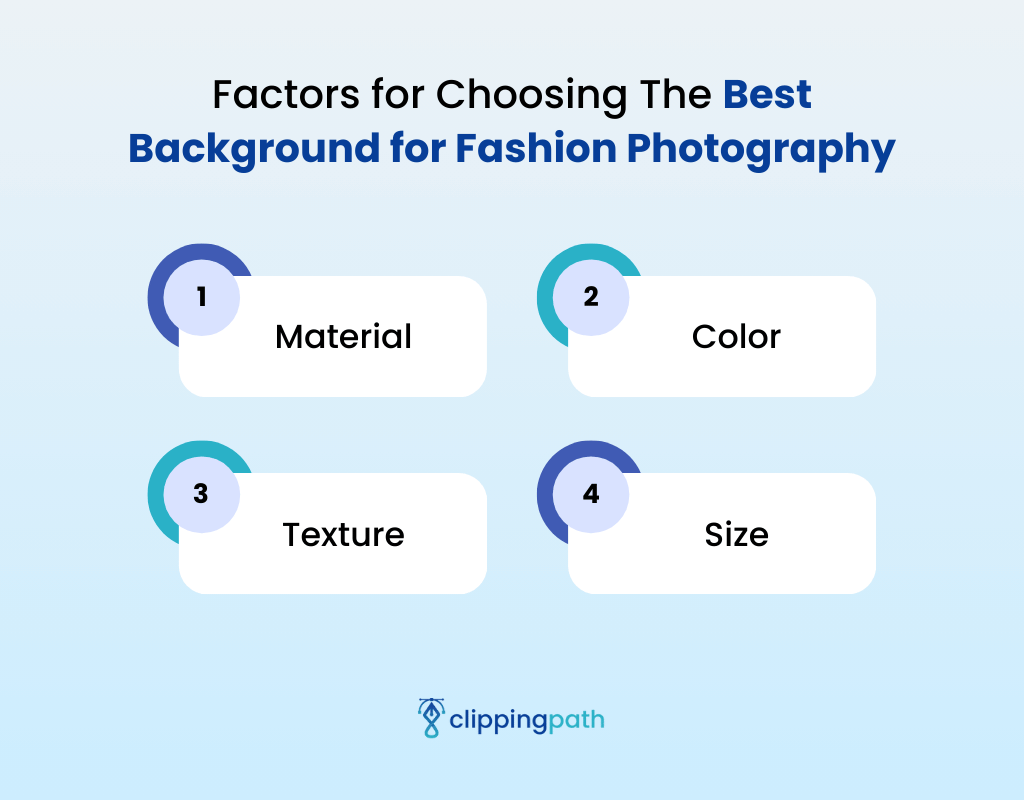
1. Material
The material affects the visual appeal of the background. The different materials also vary in price and require changing levels of maintenance. All of this affects which background will be right for you.
For instance, canvas offers a textured, artistic look, while paper provides a smooth, seamless finish. Muslin and chiffon can be dyed or painted to match specific themes.
2. Color
Choosing the right color for a fashion photography background makes it possible to set the mood and theme for the photoshoot.
Neutral colors like gray, white, and black offer versatility and professionalism, complementing a wide range of outfits without distraction. Bright colors, such as red or blue, create a bold, eye-catching contrast.
With these colored backdrops, you can shoot more bold and whimsical pieces. Pastels are well-suited for spring and summer collection photoshoots.
3. Texture
Incorporating various textures into your backdrop can make your photos much more interesting. For example, using lights and shadows to create an illusion of texture on a plain backdrop can make the photo more interesting.
You can layer other fabrics on a canvas or vinyl backdrop or add natural textures with leaves, flowers, etc., to add more dimension. Using textured furniture, rugs, etc., to make the background more interesting is also a classic way to incorporate different textures.
4. Size
Depending on the type of photos you want, you may require different backdrop sizes to capture the shots. Here are the most common sizes of backdrops:
| Backdrop Size (feet) | Type of Shots | Best For |
| 5’ x 7’ | Headshots, portraits, small product shots | Close-up shots, detail-focused photography |
| 6’ x 9’ | Half-body portraits, three-quarter shots | Individual portraits, small studio setups |
| 8’ x 10’ | Full-body portraits, small group photos | Fashion photography, editorial shoots |
| 10’ x 12’ | Full-body portraits, small to medium group photos, editorial shoots | Versatile portrait sessions, small to medium groups |
| 10’ x 20’ | Full-body portraits, large group photos, dynamic poses, and fashion shoots requiring more space for movement and props | Large group photography, dynamic fashion shoots, elaborate setups |
Best Background Color for Fashion Photography
Different colors evoke different feelings in the viewers. Colors are essential to set the right tone and mood for your editorial shots or fashion product photography. Here are the advantages of using each color scheme.
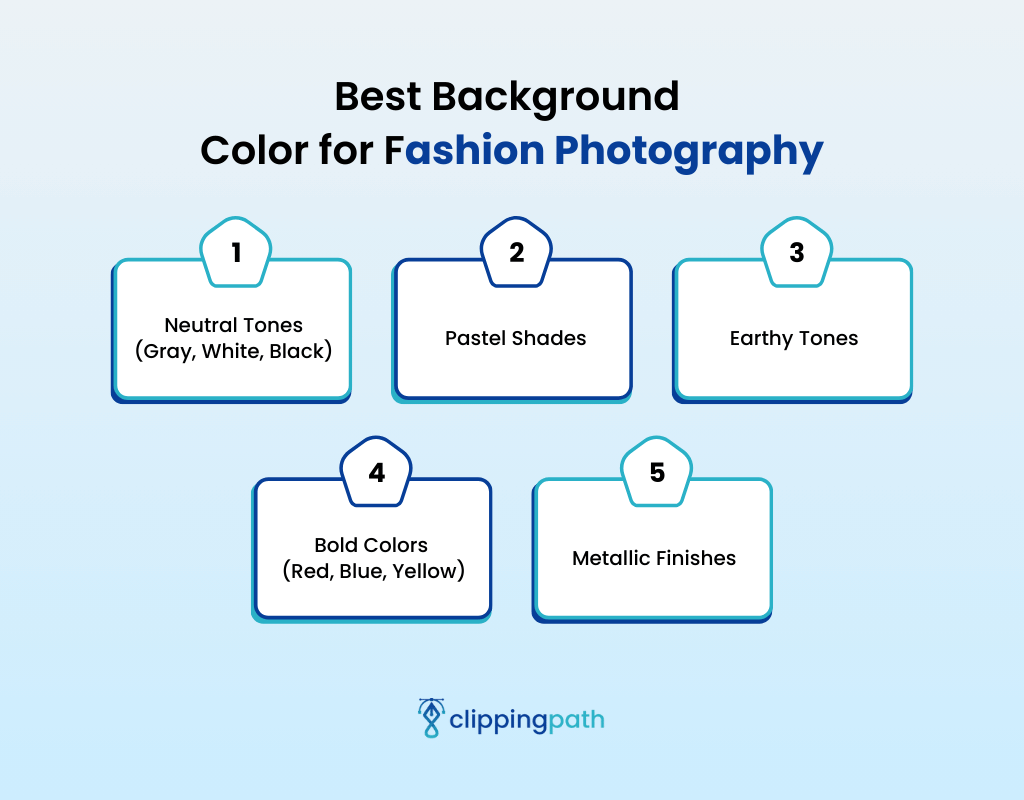
1. Neutral Tones (Gray, White, Black)
Neutral backdrops are best for photography genres where the focus is on the subject or product being showcased. It draws attention to the clothing and accessories, allowing the colors and textures of the garments to stand out without distraction.
It also gives a professional and sophisticated vibe, which is important for commercial and editorial fashion photography. Moreover, it allows more flexibility in post-production editing and adjustments.
2. Pastel Shades
The soft girl aesthetic is all over the internet and TikTok. It’s all about pastels, small cute prints, and patterns on overly feminine silhouettes.
For photoshoots that fit this romantic, whimsical vibe, pastel backdrops are best with shades of baby pink, lavender, or pale blue.
Moreover, spring and summer collection photoshoots also go well with these fresh and soothing colors.
3. Earthy Tones
Earthy tones are also an option for bohemian-style or rustic photoshoots. They blend well with natural elements like leaves and flowers.
For casual wear, you can do a photoshoot featuring very vibrant colors that contrast nicely with the muted, earthy backdrops.
4. Bold Colors (Red, Blue, Yellow)
Bold colored-backdrops offer an editorial aesthetic and give you lively images that capture viewers’ attention.
To focus on your subject, you need to pick contrasting hues for the backdrop. Knowledge of color theory will help you make this decision.
Colors are very effective at conveying moods and emotions; you can also use backdrop colors to keep a theme for your images.
5. Metallic Finishes
Metallic backgrounds are often used in high-end fashion shoots. You’ll see a lot of editorial shots feature a silver, gold, or bronze metallic backdrop.
The slight sheen to the backdrop creates a nice visual effect and adds a touch of luxury to the overall images.
Best Fabrics for Fashion Photography Background
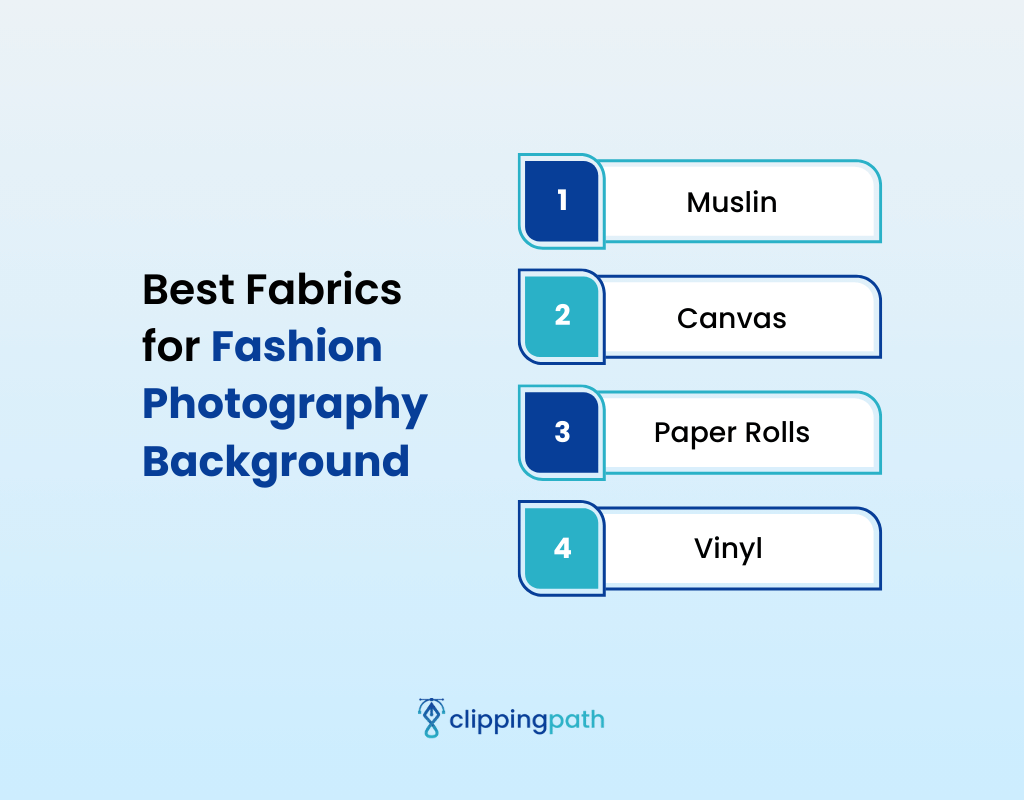
Showing off the outfits worn by your model and adding an aspirational quality to them is all that fashion photography is about.
With a stunning backdrop, you can enhance the beauty of your subject more than ever. Here are some fabric backdrops to try:
1. Muslin
Muslin is a lightweight, easy-to-fold, and store-away fabric that can be dyed and painted to match various themes. It has a matt finish, and you can get it completely smooth or wrinkle it up for some texture.
If you play with other props and elements, you can make it look vintage, artistic, and charming. It’s a very versatile fabric.
Moreover, it’s machine washable, and you can iron it to make it smooth. It’s easy to maintain and reusable. It’s also affordable, given that a 10’ x 10’ muslin backdrop costs around $23.
2. Canvas
Canvas backdrops offer a more textured appearance and are more durable. With different color options, you can get backdrops that fit any theme. Moreover, you can customize them by hand painting if you want a more detailed backdrop.
It’s also more fit for outdoor shoots as it’s heavier and stays in place better. You can also mount it on a frame to make it more sturdy.
However, the material is not machine-washable, and your best bet is to spot clean it. But it’s sturdy and can be reused many times if you store it properly. Plus, it’s super affordable, with an 8’ x 10’ backdrop costing only $19.
3. Paper Rolls
Paper backgrounds are cost-effective and provide a wide range of options. They offer a smooth backdrop in different solid colors for clean, professional shots. Moreover, they are disposable, and they can’t be cleaned.
These backdrops are sold in rolls that need to be mounted on a frame that supports the rolls. You can simply roll it out to prepare for the photoshoot. However, handling with care is important as the paper can tear.
4. Vinyl
Vinyl backdrops come in various textures and patterns or you can get a smooth, reflective surface in solid colors.
The options are endless with vinyl. You get a polished, high-quality finish that is perfect for product photography of fashion accessories like bags and jewelry photography.
However, they are heavier than paper, which makes them more suitable for outdoor shoots. You can roll them up and store them away for later use. They’re also resistant to wrinkles and easily cleanable with a damp cloth.
Pro-Tips for Aesthetic Background for Clothing Photography
Here are some general tips that will help you create a background for clothes photography that is aesthetically pleasing and professional.
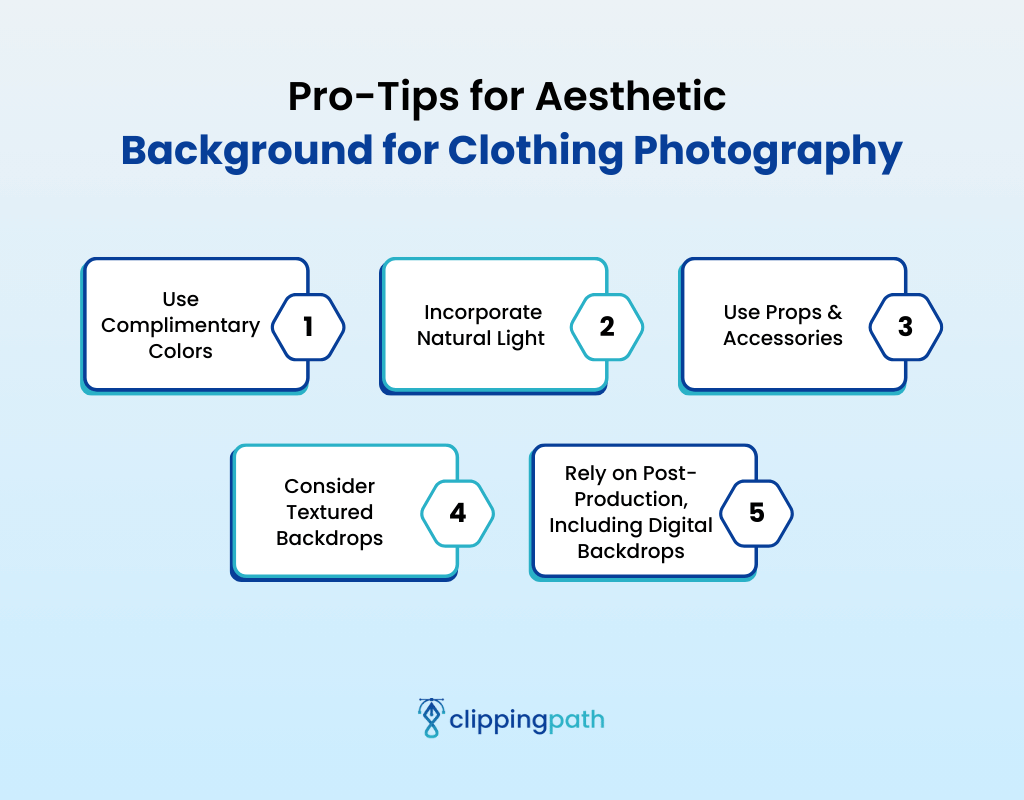
1. Use Complimentary Colors
Always make sure that the color of the backdrop complements the color of the clothing and accessories you want to highlight. Neutral-colored backdrops go well with every shade, so you can expect them to be versatile as well as professional-looking.
While choosing other solid colors for the backdrop, you should consider color theory. Look up the color wheel to find out which colors will complement the outfits you’re photographing.
2. Incorporate Natural Light
Diffused studio lights are a great tool to avoid harsh shadows. However, natural light can offer a soft and delicate touch that is still missing in studio lighting.
It will also help achieve accurate colors of the outfit in the pictures and make the clothing look more flattering by enhancing the details.
You can use reflectors or sheer curtains to minimize harsh natural light during midday hours. Sunlight has a way of adding depth and dimension naturally while capturing fabric details and texture.
3. Use Props & Accessories
A plain background isn’t interesting enough. It may make your image look bland. If you want to set a theme and make your photos more engaging, use props and accessories.
It’s also a great way to add depth to your image by placing some objects closer to the camera while others are further back.
4. Consider Textured Backdrops
Trying various textures like wood, stone, or brick can be a great way to make your picture more interesting. You can also try more exquisite textures like velvet. Moreover, layering various textures also does the trick.
Maybe you can take a solid colored paper or vinyl backdrop and partially drape some fabric on it while placing other accessories to bring it all together.
5. Rely on Post-Production, Including Digital Backdrops
Applying digital backdrops can be a simple and cost-effective way to enhance your pictures. There are countless free backdrops available, offering different patterns, colors, and vibes.
You can digitally remove the original background and place your subject in front of these digital backgrounds. This way, you save up a lot of money that will go into setting up a physical backdrop, not to mention effort and time.
How to Use Photoshop to Create The Right Digital Backdrop for Your Images
To adjust the backdrop in Photoshop, you need to separate the subject from the original background before removing the background in Photoshop.
Then, add a new layer to create a new background by filling it with colors. You can add a gradient or background effects to play around with the background to find the right fit. You can also add any image you have as a background as the new layer instead of filling it with solid color.
1. Removing Original Background
- Start up Adobe Photoshop, Select File>Open and click on the image file you want to edit.
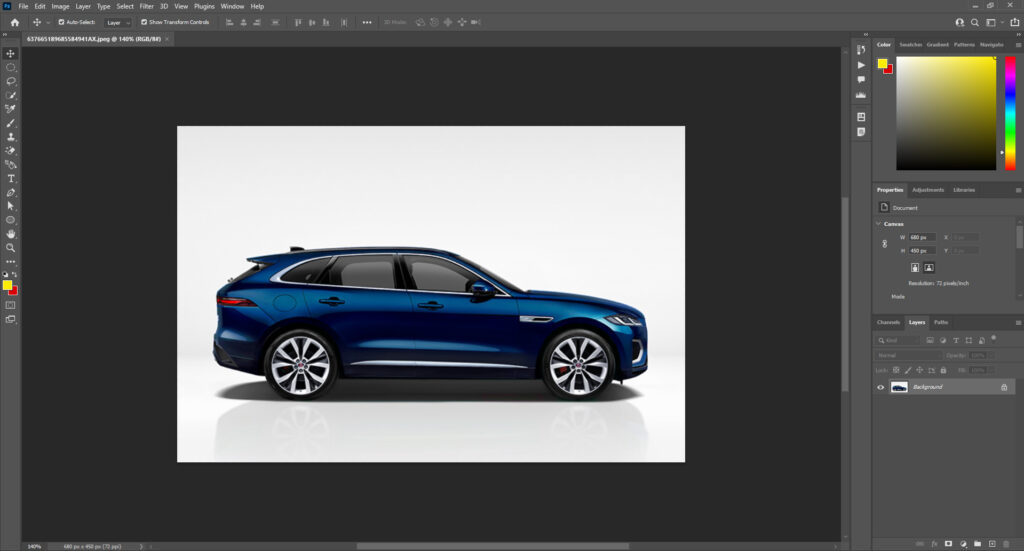
- Right-click on the image layer in the Layers panel and select Duplicate Layer to preserve the image before editing.
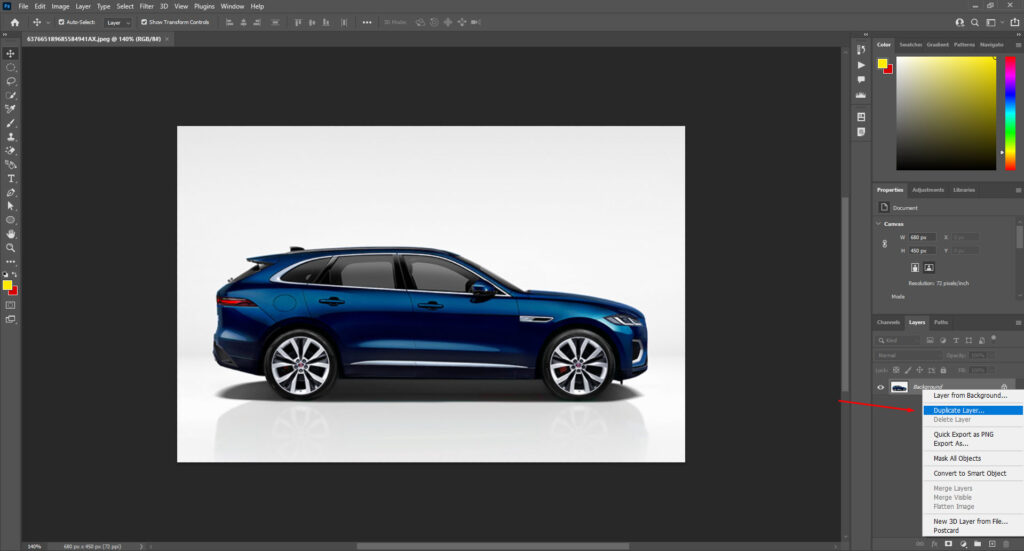
- Select the Quick Selection Tool or the Magic Wand Tool and adjust the size to your comfort. Carefully select the subject around the edges.
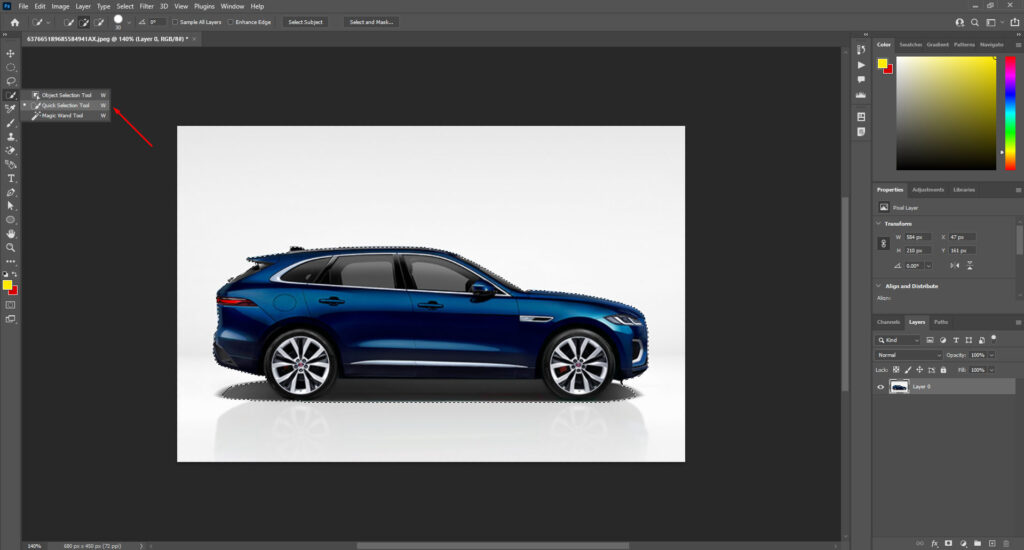
- Go to Select > Select and Mask to smooth out the edges of your selection
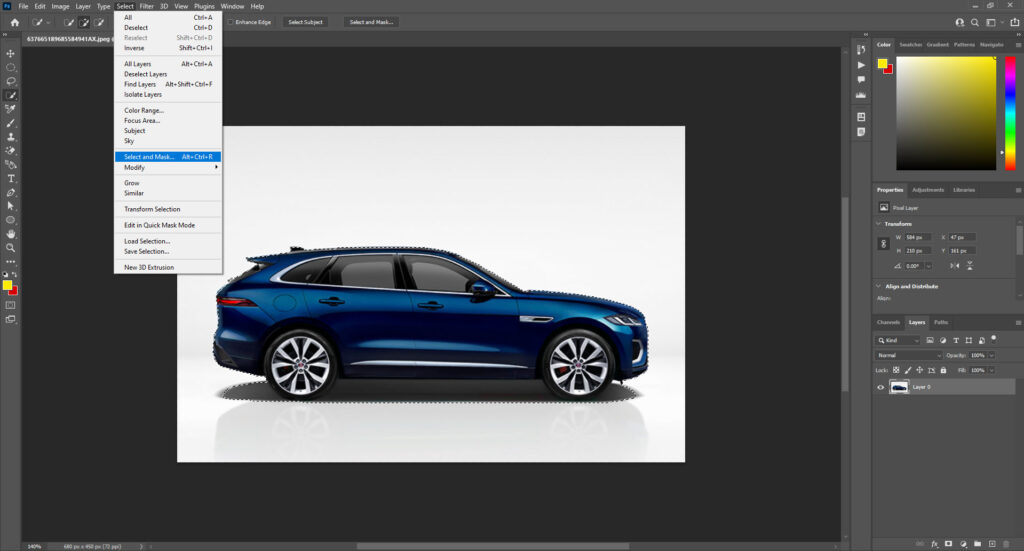
- Create a layer mask by clicking the Add Layer Mask button in the Layers panel to remove or hide the original background.
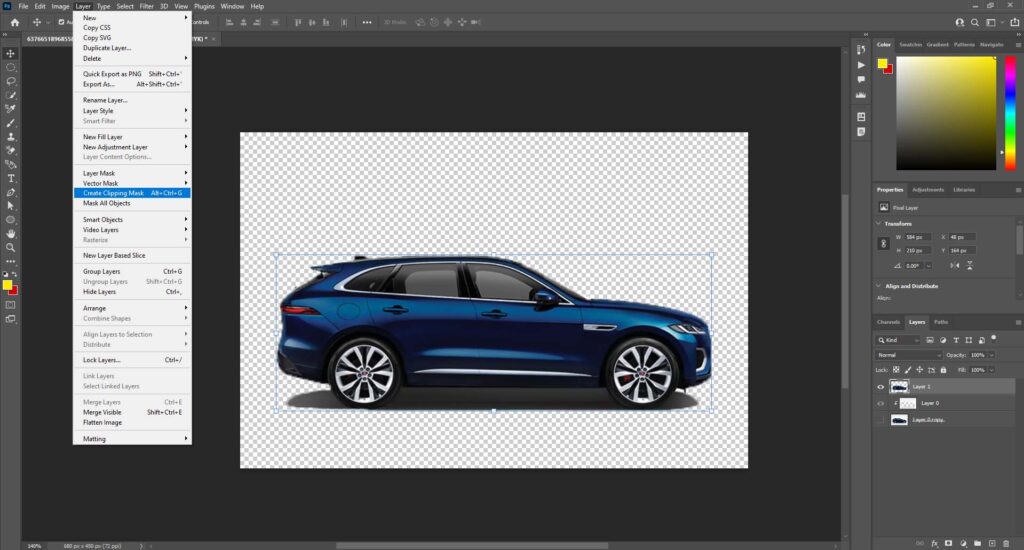
2. Create a New Background
- You can drag an image you want to add as a background and drop it into the project below the layer of the subject.
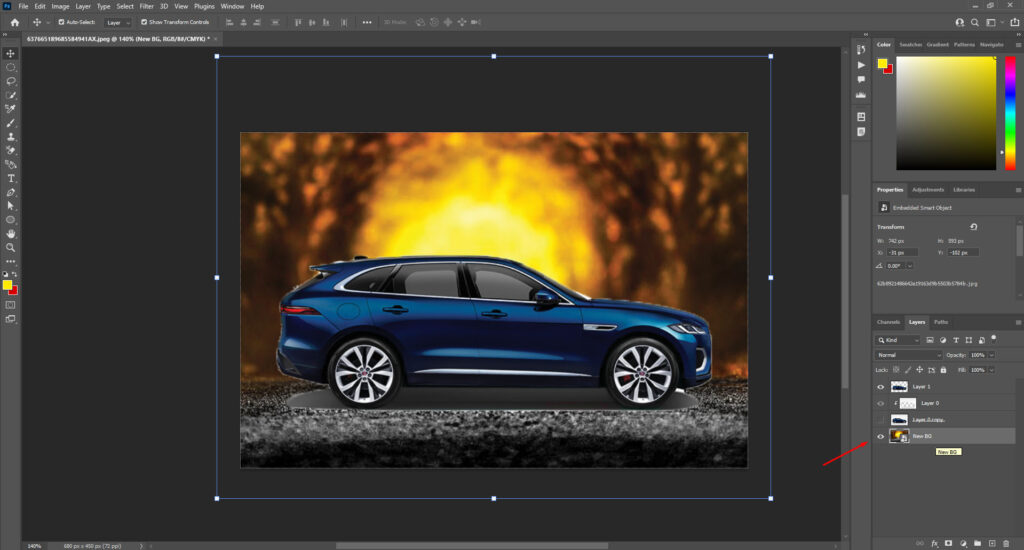
- Or create a new background by going to Layer > New Fill Layer > Solid Color to create a solid color background.
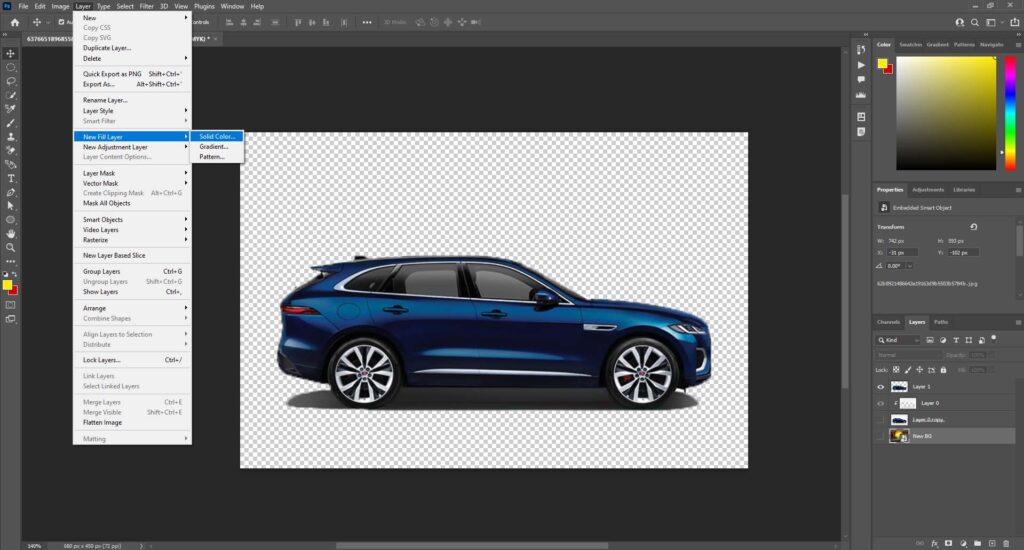
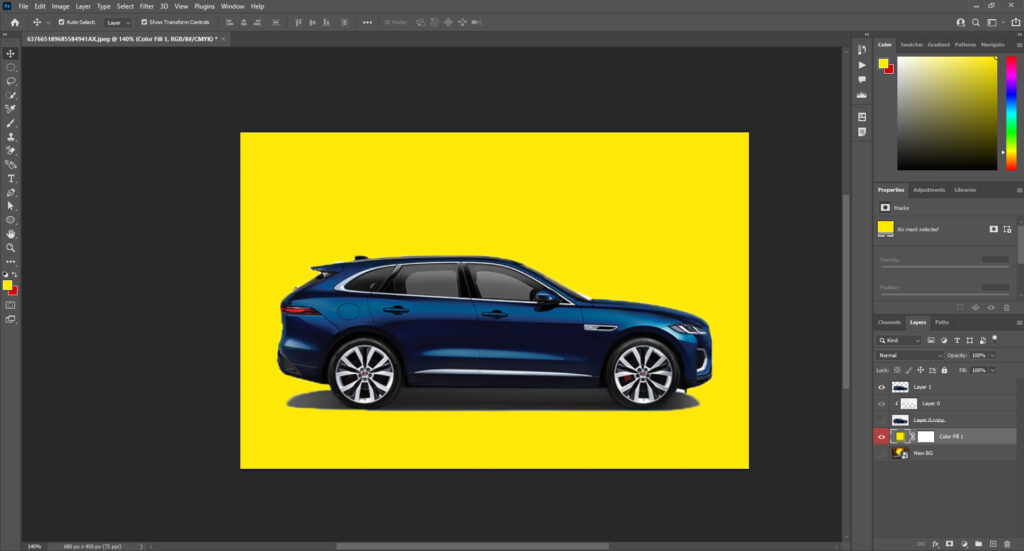
- Select Gradient Tool to add a gradient background
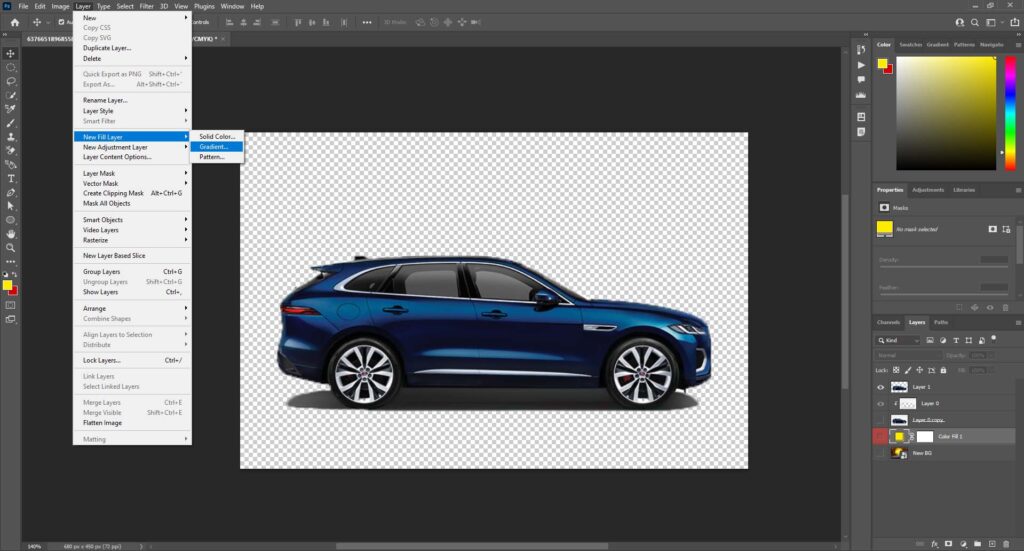

- You can add patterns by going to Layer > New Fill Layer > Pattern.
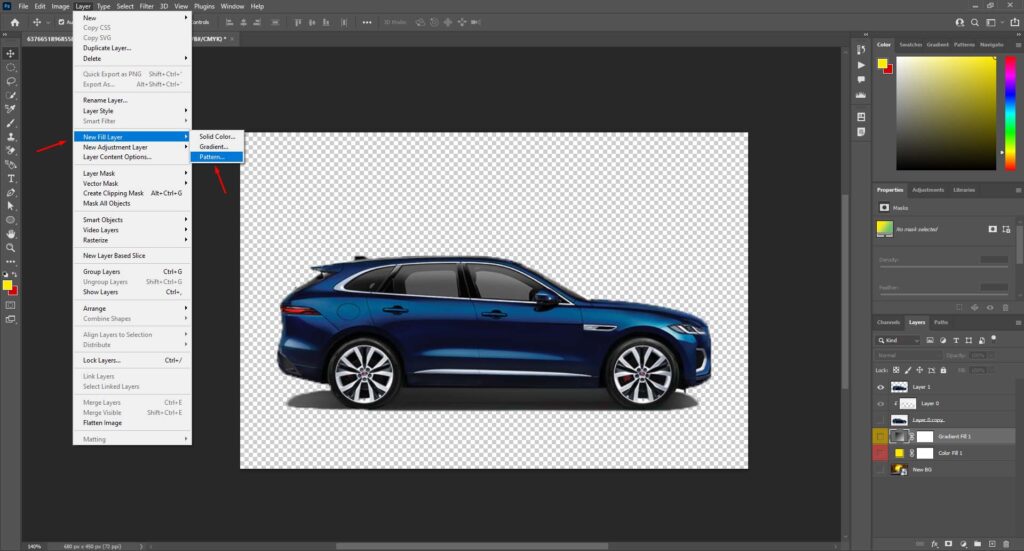
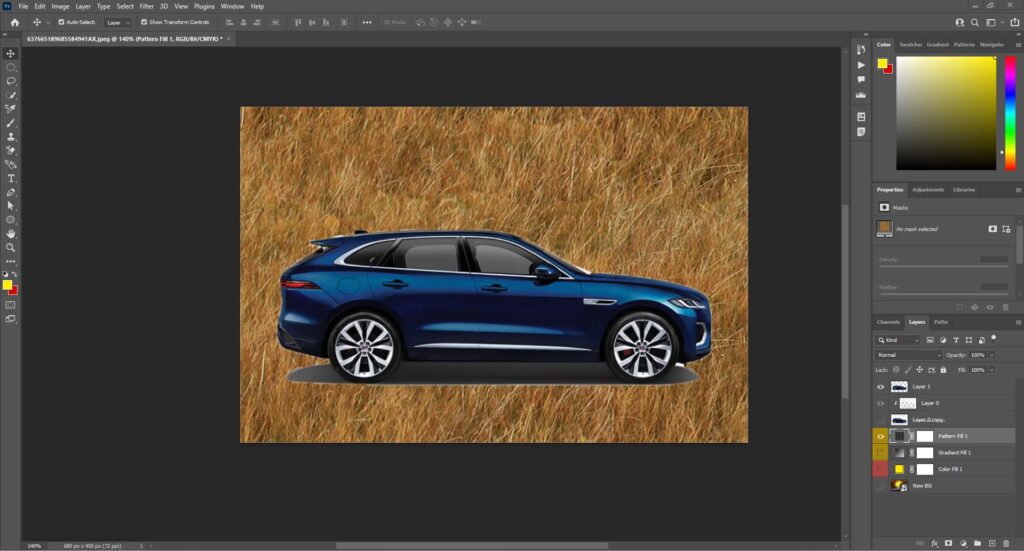
3. Blending & Refining
- Further edit the background to adjust Levels, Curves, Hue, Saturation, and Color Balance. This will blend the subject with the new background.
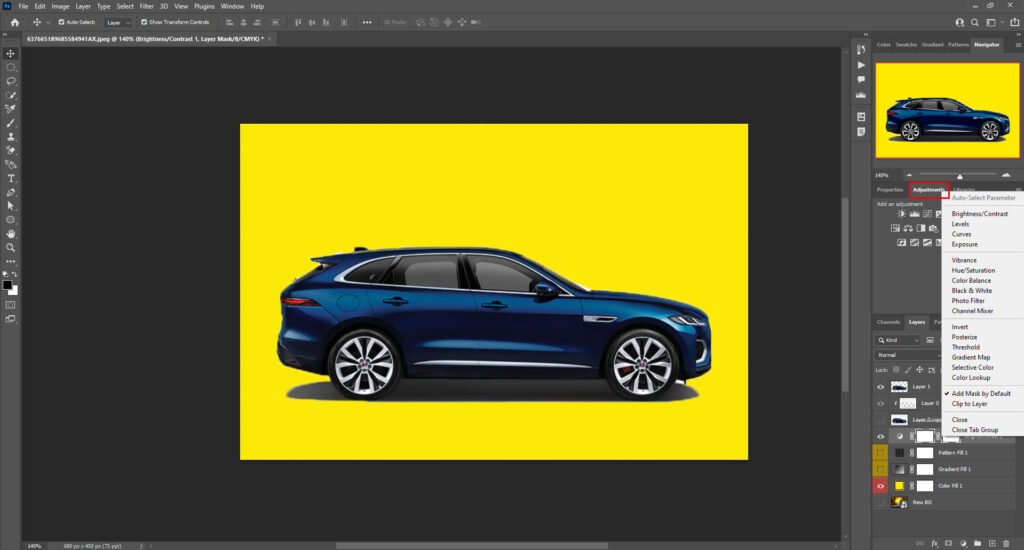
- Add realistic shadows and highlights to blend the subject naturally into the new background.
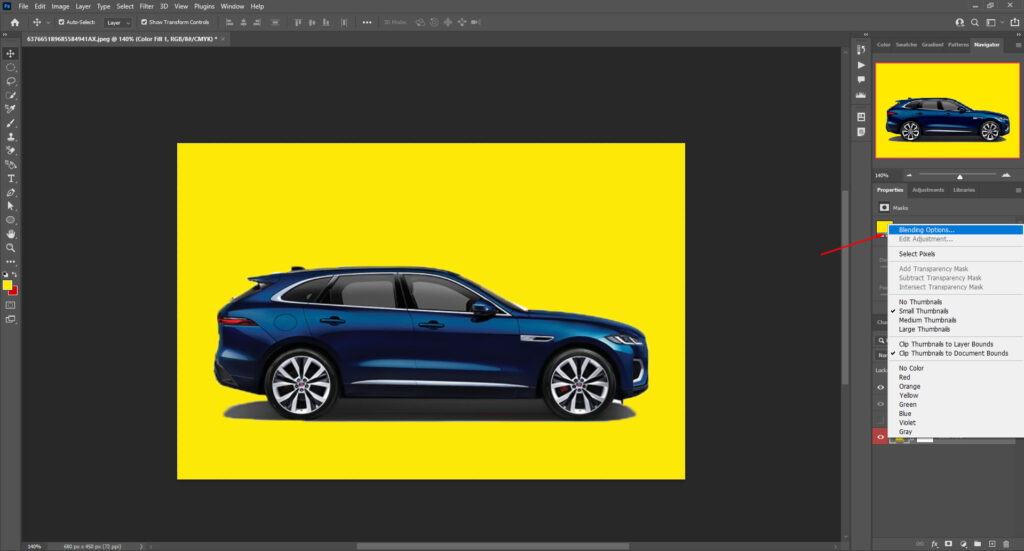
- Create a new layer, use a soft brush with low opacity, and paint shadows or highlights where needed.
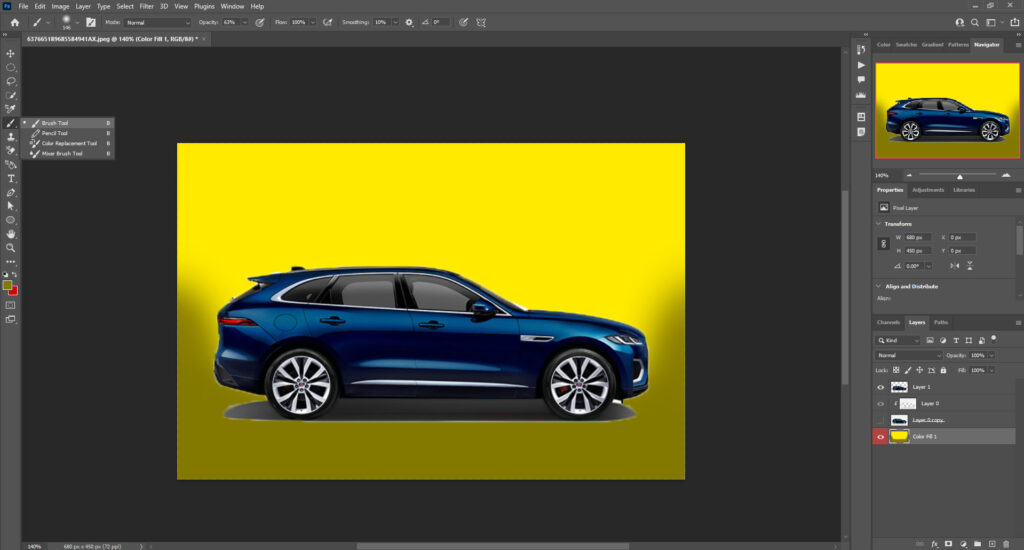
- To apply blur effects to the background to create depth of field, go to Filter > Blur and choose Gaussian Blur or Lens Blur.
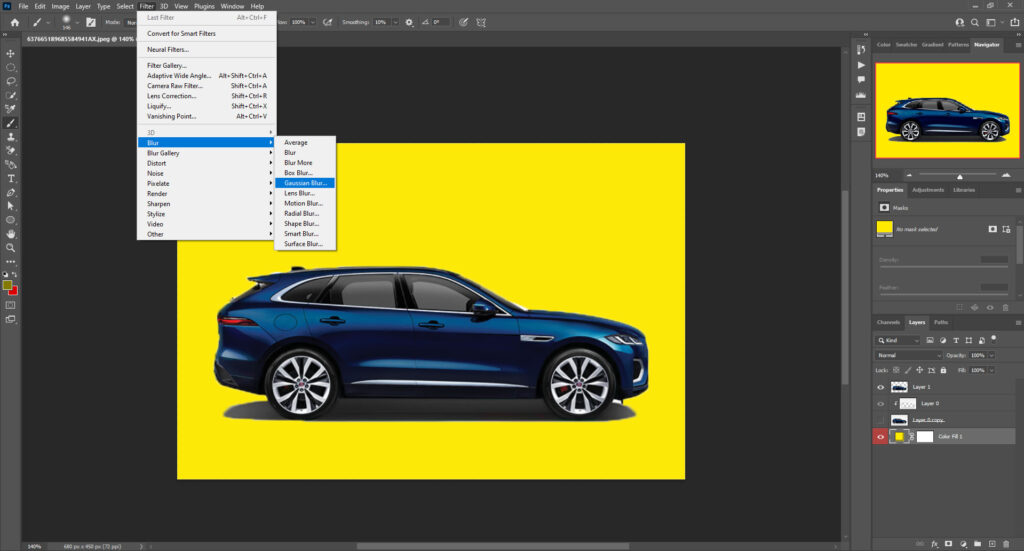
Final Words
Finally, choosing the best background for fashion photography will become easier with experience. Starting out, you should focus on different materials, themes, color combinations, and editing techniques.
Hopefully, we have provided you with a foundational understanding of fashion photography backgrounds but you will learn more as you practice.
However, if you want to play it safe, you can go for neutral colors and a smooth textured material like paper. You’ll get a professional look.
Adding props and playing with the lighting will add depth to a simple background and make the results more interesting.
FAQs
Here are some frequently asked questions about the best background for fashion photography.
Where can I get clear background images?
Unsplash, Pexels, Pixabay, Freepik, Freeimages, etc. are all great platforms for finding background images that can be used for post-production adjustments. It’s a great way to scale up your photography.
Which is the best photo background editor?
Adobe Photoshop, Lightroom, Photoroom, Picsart, Fotor, and VanceAI are great digital tools to enhance your pictures’ backgrounds.
What is the best shutter speed for fashion photography?
The best shutter speed for fashion photography is typically between 1/125 to 1/500 second, depending on lighting and movement. This range ensures sharp images, freezes motion, and works well with studio lighting or natural light conditions.
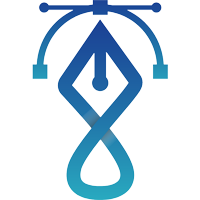
Meta Clipping Path – A well-known one-stop photo editing service provider company with 5+ years of experience and 25+ highly skilled professionals.
Working with 20 reputed worldwide e-commerce companies and 200+ satisfied customers.
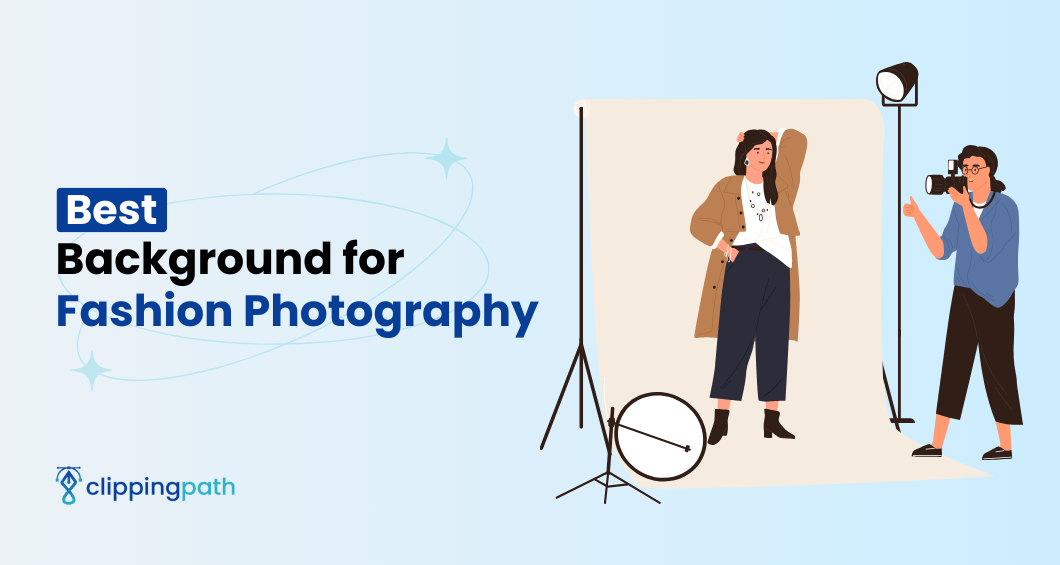
![Read more about the article How to Change Background for Photography Editing [Edit Photos on Photoshop Like a Pro]](https://metaclippingpath.com/wp-content/uploads/2024/06/Background-for-Photography-Editing-300x160.png)

![Read more about the article How to Make Background White [A Complete Guide]](https://metaclippingpath.com/wp-content/uploads/2024/07/How-to-Make-Background-White-300x160.png)